 Cover art by Hal Foster | |
| Years active | 1989 |
|---|---|
| Genres | Arthurian fantasy |
Prince Valiant: The Story-Telling Game is a licensed role-playing game published by Chaosium in 1989 that is based on Hal Foster's comic strip of the same name.
 Cover art by Hal Foster | |
| Years active | 1989 |
|---|---|
| Genres | Arthurian fantasy |
Prince Valiant: The Story-Telling Game is a licensed role-playing game published by Chaosium in 1989 that is based on Hal Foster's comic strip of the same name.
In Prince Valiant, players take on the roles of knights in King Arthur's court, taking part in adventures styled after the Prince Valiant comics. The game is designed for children and young adults, [1] with an emphasis on story-telling — designer Greg Stafford claimed that Prince Valiant was the first story-telling role-playing game. [2] The basic game mechanics, covered in a single page, are intentionally simple so as to emphasize story-telling over rules. [3] More advanced rules are available that include more skills such as Bargaining, Disguise, and Farming. [3]
Although there is a gamemaster called a Storyteller, all the players are responsible for telling part of the story. As Greg Stafford explained in an interview: "Each player ... owns part of the scenario and must present it to the others, who themselves know other elements of the story, so everyone participates in the evolution of the plot." [4]
Each player creates a knight by:
The game substitutes coin flips for dice rolling to resolve all combat and skill challenges. The points each character was assigned for attributes and skills represent a certain number of coins. One knight, for example, might have an assigned Brawn of 5 points and a Presence of 3 points; when a situation calls for Brawn, the player in question flips five coins, and is successful if any of them come up "Heads". In combat or jousting, both opponents flip their respective number of coins — the one with the most heads is the winner. [5]
Rather than measuring a character's health with hit points, a character loses Brawn coins, and must rest or be Healed to recover Brawn. [3]
As the game progresses, a knight's achievements are measured by Fame points; the character with the highest number of Fame points is the party leader. Fame points can be exchanged for higher coin ratings in certain skills. [3]
The game book includes twenty short adventures. [3]
The weekly comic strip Prince Valiant was created by Hal Foster in 1937 and rapidly became popular, appearing weekly in more than 300 American newspapers via King Features Syndicate. [6] In 1989, Chaosium acquired the game license, and Greg Stafford created the 128-page softcover book Prince Valiant: The Story-Telling Game, with contributions from William Dunn and Lynn Willis and with black-and-white artwork by Hal Foster and John Cullen Murphy.
Peter Corless, writing in the 2002 book King Arthur in Popular Culture, noted that "the game was modestly received, discontinued, and is now out of print". [1]
Game historian St Horvath noted, "Greg Stafford's love of the legends of King Arthur is well known, and his admiration for Hal Foster glow bright in the pages of the Prince Valiant" rulebook, but ... this was not a property that people were going to go wild for. It sold slowly." [7]
In 2019, Nocturnal Media released an updated version of the game as a hardcover book with full color illustrations. [8]
In October 1990, the game was translated and published into Spanish by the Spanish publishing house Joc Internacional (translator: Juan Ignacio Sánchez Pérez). [9]
In his 1990 book The Complete Guide to Role-Playing Games , game critic Rick Swan called this game "a near-perfect introductory RPG" and noted that "the game is packed with other clever touches". Swan also commented that "excellent sections on staging adventures, the history of the original comic strip, and magic and monsters complete the game." Swan only had one reservation, finding that "the focus of the game seems too narrow for extended play; this could've been alleviated somewhat with the inclusion of a long adventure instead of the brief scenarios included at the end of the book". Swan concluded by giving this game an excellent rating of 3.5 out of 4. [3]
In his 1991 book Heroic Worlds, Lawrence Schick called this game a "simple and elegant introductory system" and noted it was "profusely illustrated with wonderful Hal Foster art". Schick also commented that "the guidelines on how to role-play are as valuable for experienced players as for novices." [10]
In the 2010 book Family Games: The 100 Best, Robin D. Laws thought this was one role-playing game that would appeal to all ages, writing that it serves up "thrill and derring-do with a positive, clean-cut context. [Its] reassuring good nature appeals to younger kids, though [it] offers plenty of Vikings, clashing swords, and suits of armor to hook the fancy of older ones." Laws concluded with a strong recommendation, saying: "The solid structure of Prince Valiant provides the ideal platform for the family gamer to introduce his or her brood to the joys of role-playing. This is only fitting, as lead designer Greg Stafford's love of storytelling in general and the classic strips of Hal Foster shines through on every infectious page." [5]
In his 2014 book Designers & Dragons, game historian Shannon Appelcline noted the "strong, storytelling basis, the use of a coin as a randomizer, a one-page game system, matched player and character reward systems, and an early troupe style system that allowed players to become storytellers for brief scenes" and commented "Prince Valiant was unsupplemented, but if it had received more attention, it probably would have become a pivotal storytelling game, as important for its new roleplaying ideas as other releases of the time like Chaosium's own Pendragon (1985), Lion Rampant's Ars Magica (1987), and White Wolf's Vampire: The Masquerade (1991). Even without that, some 'indie' designers of the modern day note its influence." [11]
In his 2023 book Monsters, Aliens, and Holes in the Ground, RPG historian Stu Horvath noted, "In the coming decade [the 1990s], RPGs would move away from elaborate systems of simulation and become interested in encouraging narrative in a variety of ways ... The game might not owe a direct debt to Prince Valiant, but Prince Valiant was nevertheless at the forefront of a new style of play." [7]
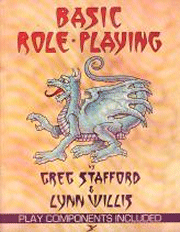
Basic Role-Playing (BRP) is a tabletop role-playing game which originated in the RuneQuest fantasy role-playing game. Chaosium released the BRP standalone booklet in 1980 in the boxed set release of the second edition of RuneQuest. Greg Stafford and Lynn Willis are credited as the authors. Chaosium used the percentile skill-based system as the basis for most of their games, including Call of Cthulhu, Stormbringer, and Elfquest.

Call of Cthulhu is a horror fiction role-playing game based on H. P. Lovecraft's story of the same name and the associated Cthulhu Mythos. The game, often abbreviated as CoC, is published by Chaosium; it was first released in 1981 and is in its seventh edition, with licensed foreign language editions available as well. Its game system is based on Chaosium's Basic Role-Playing (BRP) with additions for the horror genre. These include special rules for sanity and luck.
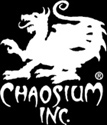
Chaosium Inc. is a publisher of tabletop role-playing games established by Greg Stafford in 1975. Chaosium's major titles include Call of Cthulhu, based on the horror fiction stories of H. P. Lovecraft, RuneQuest Glorantha, Pendragon, based on Thomas Mallory's Le Morte d'Arthur, and 7th Sea, "swashbuckling and sorcery" set in a fantasy 17th century Europe.

RuneQuest is a fantasy tabletop role-playing game originally designed by Steve Perrin, Ray Turney, Steve Henderson, and Warren James, and set in Greg Stafford's mythical world of Glorantha. It was first published in 1978 by The Chaosium. Beginning in 1984, publication passed between a number of companies, including Avalon Hill, Mongoose Publishing, and The Design Mechanism, before finally returning to Chaosium in 2016. RuneQuest is notable for its system, designed around percentile dice and an early implementation of skill rules, which became the basis for numerous other games. There have been several editions of the game.

The Ringworld science fiction role-playing game was published by Chaosium in 1984, using the Basic Role-Playing system for its rules and Larry Niven's Ringworld novels as a setting.

Prince Valiant in the Days of King Arthur, often simply called Prince Valiant, is an American comic strip created by Hal Foster in 1937. It is an epic adventure that has told a continuous story during its entire history, and the full stretch of that story now totals more than 4000 Sunday strips. The strip appears weekly in more than 300 American newspapers, according to its distributor, King Features Syndicate.
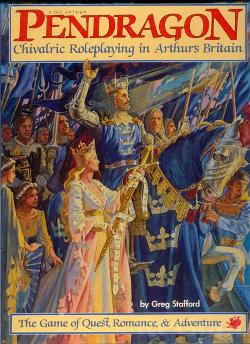
Pendragon, or King Arthur Pendragon, is a Tabletop role-playing game (RPG) in which players take the role of knights performing chivalric deeds in the tradition of Arthurian legend. It was originally written by Greg Stafford and published by Chaosium, then was acquired by Green Knight Publishing, who in turn passed on the rights to White Wolf Publishing in 2004. White Wolf sold the game to Stewart Wieck in 2009. Wieck formed Nocturnal Media, who updated and reissued the 5th edition originally published by White Wolf. In 2018, it returned to Chaosium.

Francis Gregory Stafford was an American game designer, publisher, and practitioner of shamanism.

HeroQuest is a role-playing game written by Robin D. Laws first published as Hero Wars by Issaries, Inc. in 2000. It has its roots in Greg Stafford's fantasy world of Glorantha, but was designed as a generic system, suitable for, but not tied to any particular genre.

Conan Unchained! is a 1984 adventure module for the Dungeons & Dragons roleplaying game that centers on an adventure of the fictional hero Conan the Barbarian and his companions.

Stormbringer is a fantasy tabletop role-playing game published under license by Chaosium. Based on the Elric of Melniboné books by Michael Moorcock, the game takes its name from Elric's sword, Stormbringer. The rules are based on Chaosium's percentile-dice-based Basic Role-Playing system.
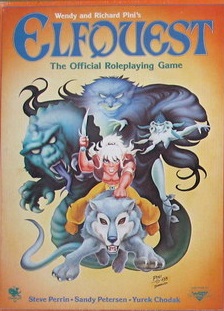
Elfquest is a fantasy role-playing game published by Chaosium in 1984 that is based on Wendy and Richard Pini's Elfquest series of comics.

The Bullwinkle and Rocky Role-Playing Party Game is a role-playing game published by TSR in 1988. It is based on characters and settings from The Rocky and Bullwinkle Show.

Cults of Prax is a supplement published by Chaosium in 1979 for the fantasy role-playing game RuneQuest that describes the various religions that are central to the game. It was republished in 2016 in PDF format as part of Chaosium's RuneQuest: Classic Edition Kickstarter.

Cities is a fantasy role-playing game supplement that was first published by Midkemia Press in 1979. The supplement was designed to be used with any role-playing game system, and provides information about using urban center as part of adventures. Midkemia published a second edition in 1980, Chaosium published a third edition in 1986, and Avalon Hill published a fourth edition in 1988 for the RuneQuest role-playing game. The various editions received positive reviews in game periodicals including The Space Gamer, Different Worlds, Dragon, White Dwarf, Casus Belli, and Games International.
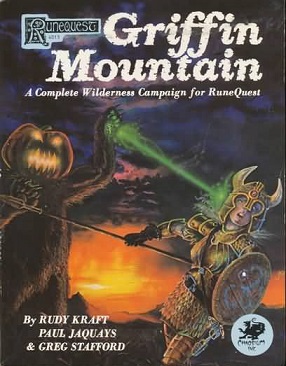
Griffin Mountain is a tabletop role-playing game supplement for RuneQuest, written by Rudy Kraft, Jennell Jaquays, and Greg Stafford, and published by Chaosium in 1981. Griffin Mountain is a wilderness campaign setting for the RuneQuest system, focussed on the land of Balazar and the Elder Wilds. It contains role-playing material to help gamemasters design adventures in the setting. It received positive reviews in game periodicals including Ares, White Dwarf, The Space Gamer, and Dragon.

Pavis: Threshold to Danger is a boxed tabletop role-playing game supplement for RuneQuest, originally published by Chaosium in 1983. This boxed set detailed the fictional city of New Pavis for use in role-playing adventures. It received positive reviews in game periodicals including White Dwarf, Dragon, Different Worlds, and Fantasy Gamer. The set was republished in 1999 by Moon Design Publications in a single volume with Big Rubble: The Deadly City as Gloranthan Classics Volume I – Pavis & Big Rubble. The 1983 edition was republished in 2019 in PDF format as part of Chaosium's RuneQuest: Classic Edition Kickstarter.

The Asylum & Other Tales is an anthology of seven adventures published by Chaosium in 1983 for the horror role-playing game Call of Cthulhu.
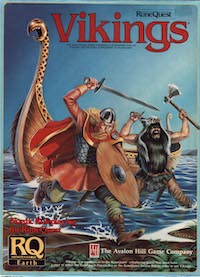
Vikings, Nordic Roleplaying for RuneQuest is a boxed tabletop role playing game supplement, written by Greg Stafford and Sandy Petersen, with a cover by Steve Purcell. Published under license by Avalon Hill in 1985 for Chaosium's fantasy role-playing game RuneQuest.

Snakepipe Hollow is an adventure published by Chaosium in 1979 for the fantasy role-playing game RuneQuest, then revised and republished in various editions.